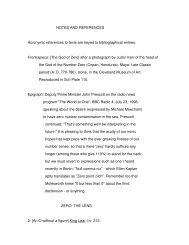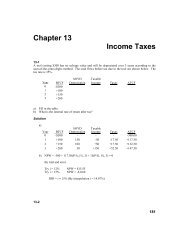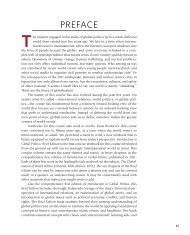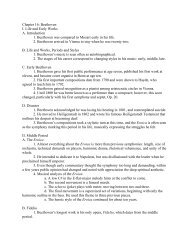CHAPTER 3 Consumer Preferences and Choice
CHAPTER 3 Consumer Preferences and Choice
CHAPTER 3 Consumer Preferences and Choice
You also want an ePaper? Increase the reach of your titles
YUMPU automatically turns print PDFs into web optimized ePapers that Google loves.
03-Salvatore-Chap03.qxd 08-08-2008 12:41 PM Page 65<br />
Marginal rate of<br />
substitution (MRS)<br />
The amount of a good<br />
that a consumer is<br />
willing to give up for an<br />
additional unit of<br />
another good while<br />
remaining on the same<br />
indifference curve.<br />
<strong>CHAPTER</strong> 3 <strong>Consumer</strong> <strong>Preferences</strong> <strong>and</strong> <strong>Choice</strong> 65<br />
Indifference curves also cannot intersect. Intersecting curves are inconsistent with<br />
the definition of indifference curves. For example, if curve 1 <strong>and</strong> curve 2 in the right<br />
panel of Figure 3.3 were indifference curves, they would indicate that basket A*<br />
is equivalent to basket C* since both A* <strong>and</strong> C* are on curve 1, <strong>and</strong> also that basket<br />
B* is equivalent to basket C* since both B* <strong>and</strong> C* are on curve 2. By transitivity, B*<br />
should then be equivalent to A*. However, this is impossible because basket B* contains<br />
more of both good X <strong>and</strong> good Y than basket A*. Thus, indifference curves cannot<br />
intersect.<br />
Indifference curves are usually convex to the origin; that is, they lie above any tangent<br />
to the curve. Convexity results from or is a reflection of a decreasing marginal rate<br />
of substitution, which is discussed next.<br />
The Marginal Rate of Substitution<br />
The marginal rate of substitution (MRS) refers to the amount of one good that an individual<br />
is willing to give up for an additional unit of another good while maintaining the<br />
same level of satisfaction or remaining on the same indifference curve. For example, the<br />
marginal rate of substitution of good X for good Y (MRSXY) refers to the amount of Y that<br />
the individual is willing to exchange per unit of X <strong>and</strong> maintain the same level of satisfaction.<br />
Note that MRSXY measures the downward vertical distance (the amount of Y that the<br />
individual is willing to give up) per unit of horizontal distance (i.e., per additional unit of X<br />
required) to remain on the same indifference curve. That is, MRSXY =−∆Y/∆X. Because<br />
of the reduction in Y, MRSXY is negative. However, we multiply by −1 <strong>and</strong> express MRSXY<br />
as a positive value.<br />
For example, starting at point A on U1 in Figure 3.4, the individual is willing to give<br />
up four units of Y for one additional unit of X <strong>and</strong> reach point B on U1. Thus, MRSXY =<br />
−(−4/1) = 4. This is the absolute (or positive value of the) slope of the chord from point<br />
A to point B on U1. Between point B <strong>and</strong> point C on U1, MRSXY = 3/2 = 1.5 (the absolute<br />
slope of chord BC ). Between points C <strong>and</strong> F, MRSXY = 2/3 = 0.67. At a particular point<br />
on the indifference curve, MRSXY is given by the absolute slope of the tangent to the indifference<br />
curve at that point. Different individuals usually have different indifference<br />
curves <strong>and</strong> different MRSXY (at points where their indifference curves have different<br />
slopes).<br />
We can relate indifference curves to the preceding utility analysis by pointing out that<br />
all combinations of goods X <strong>and</strong> Y on a given indifference curve refer to the same level of<br />
total utility for the individual. Thus, for a movement down a given indifference curve, the<br />
gain in utility in consuming more of good X must be equal to the loss in utility in consuming<br />
less of good Y. Specifically, the increase in consumption of good X (X) times the<br />
marginal utility that the individual receives from consuming each additional unit of X<br />
(MUX) must be equal to the reduction in Y (−Y) times the marginal utility of Y (MUY).<br />
That is,<br />
so that<br />
(X)(MUX) =−(Y)(MUY) [3.1]<br />
MUX/MUY =−Y/X = MRSXY<br />
[3.2]<br />
Thus, MRSXY is equal to the absolute slope of the indifference curve <strong>and</strong> to the ratio of the<br />
marginal utilities.
















